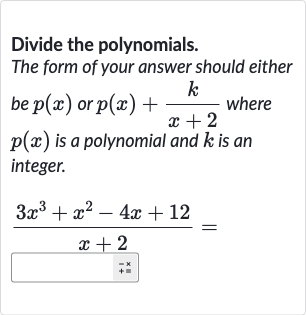Full solution
Q. Divide the polynomials.The form of your answer should either be or where is a polynomial and is an integer.
- Set up division: Set up the long division.We will use polynomial long division to divide by .
- Divide first term: Divide the first term of the numerator by the first term of the denominator.Divide by to get .Write above the division bar.
- Multiply divisor: Multiply the entire divisor by the result from Step .Multiply by to get .
- Subtract result: Subtract the result from Step from the corresponding terms of the dividend.Subtract from to get .Bring down the next term of the dividend, which is , to get .
- Divide new leading term: Divide the new leading term of the remainder by the first term of the divisor.Divide by to get .Write above the division bar next to .
- Multiply divisor again: Multiply the entire divisor by the result from Step .Multiply by to get .
- Subtract result again: Subtract the result from Step from the corresponding terms of the current remainder.Subtract from to get .Bring down the next term of the dividend, which is , to get .
- Bring down next term: Divide the new leading term of the remainder by the first term of the divisor.Divide by to get .Write above the division bar next to .
- Divide new leading term again: Multiply the entire divisor by the result from Step .Multiply by to get .
- Multiply divisor again: Subtract the result from Step from the corresponding terms of the current remainder.Subtract from to get .
- Subtract result again: Write the final answer.Since there is no remainder, the final answer is just the quotient we have found.The quotient is .

